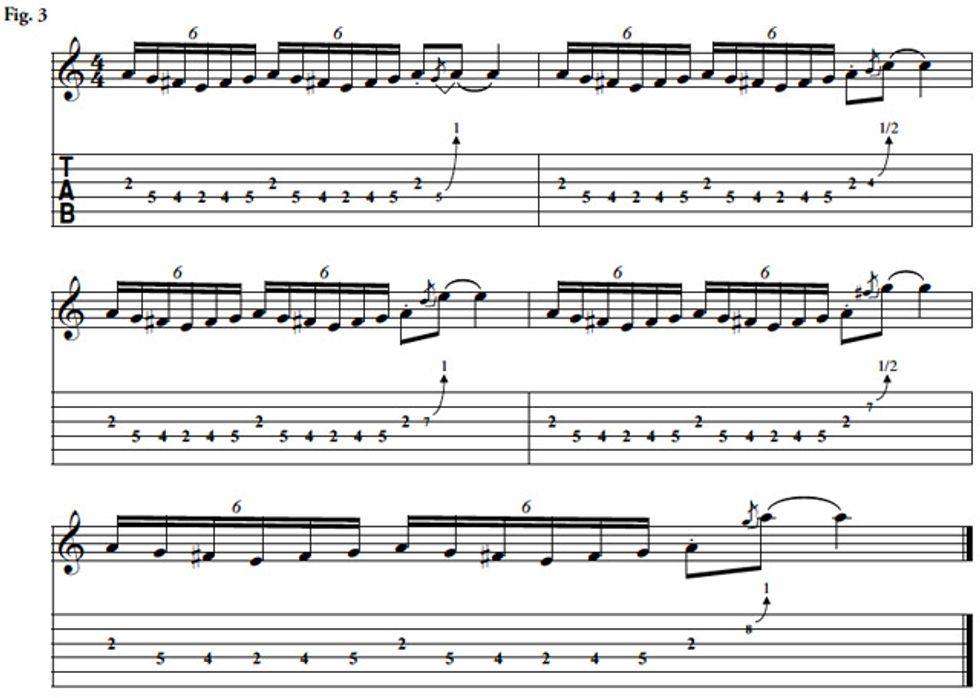My bus driver just stole all my
equipment.
Can you believe this? I just finished a
very enjoyable 40-city tour of Europe. The
band was great. The crew was great. The
audiences were great. And I thought the bus
driver was great.
Until he took off with our gear.
I mention this for three reasons. First, I
want to warn you to keep an eye on your
guitars when you’re playing the last show
of your tour. Second, to add entertainment
value to the serious musical discussion
that we’re about to get into. And third, to
make an important metaphor: Things that
go wrong are often more noticeable than
things that go right. The squeaky wheel gets
the oil, or something like that.
What is our musical “squeaky wheel” or
kleptomaniac bus driver in today’s column?
Tempos and endings. I’m going to write
this in capital letters, two-and-a-half times,
to help you remember:
TEMPOS AND ENDINGS
TEMPOS AND ENDINGS
TEMPOS AND
See! You need endings or you’re really
left hanging.
I’ve had the genuine pleasure of jamming
with hundreds of guitarists over the past
few years. The scales were great. The arpeggios
were great. The licks were great.
But the bus driver stole all the gear at
the end.
Everyone (including me) struggles with
the endings of their guitar solos. And it can
literally put a sour note on a good solo. My
goal is to find some good endings. We’re
going to start with chord tones.
Have you ever played “Stairway to
Heaven”? The first three notes are all chord
tones (root, b3, and 5). But we want to play
these notes stylishly and with emotion, and
that means bending and vibrato.
You can see in Fig. 1 how we will go
about this using these notes in a different
way. Start by playing G on the 4th string
and bend up to A (the root). This takes
some power from your hand. Use your first
three fingers (to make one giant finger),
and really grab that string and pull it up the
full whole-step. You can do it! Download Example Audio 1...

Now, play a B on the 3rd string and bend up to C (the b3). I still recommend using three fingers, but this should feel a lot easier than the previous bend. It’s just a half-step this time.
Next, play a D and bend up to E (the 5). This is probably the most common bend in all of rock ’n’ roll, so you’ve probably had some experience with this one. Once again, I recommend using three fingers to achieve the most bending power and control.
Now that you’ve bent up to the “Stairway” notes, let’s add one more useful chord tone, the b7. Play F# and bend it up to G. This is a half-step bend as well. And you guessed it, three fingers gives you all the power.
You did it!
You’ve emotionally and stylishly bent up to all the chords tones in an Am7 chord. This is fantastic. Each one of these notes is a great place to end. Now let’s make sure that you’re playing it with full stadium-rock power.
Listen to the pitch while you’re bending to make sure you’re hitting the notes dead-on. Some bends are half-steps and others are whole-steps. Your ear has to teach your fingers how far to bend. So listen closely to the pitches and make them accurate enough to stir the spirit of Ronnie James Dio and every dragon he ever wrote of slaying. Seriously, bend those notes in tune. Please.
Then shake them around a bit with some controlled vibrato to make them even more stylish.
Keep Listening. Your eyes won’t help you with this. Bending and vibrato need to be guided by what you hear. Try these bent notes again, and don’t let the evil bus driver of nervous vibrato get into your sound.
I know this is important because I watch so many guitar players who haven’t practiced bending up to chord tones. So please excuse me, but it has to be done. I want us all to sound better, and this is an easy way to immediately improve your playing.
Now let’s add a face-melting shred lick into the picture.
How do you know if you’ve earned your shred license? You are legally entitled to shred when you can transmit a tempo via your playing to the listener. In other words, if you take away the drums, bass, rhythm guitar, and keyboards from your song and just listen to the guitar solo by itself, does it still inspire you to bang your head to the beat?
Is it floating above the groove or locking in? Both ways can be musical and good. But I’ve witnessed so much playing that does not “lock in,” that I can’t help but encourage you to try it.
Let’s get back to the face melting. Check out the lick shown in Fig. 2. It begins with an upstroke, and every downbeat of the lick is always an upstroke. Also notice that the lick stops and leaves a nice hole before it starts up again. This hole is still in time, so respect the hole and don’t rush it.

Don’t worry about playing the lick fast. I want you to get the upstrokes right and play this example locked into a tempo. The tempo should be slow at first. I recommend keeping it slow for days (or even weeks) while you listen to the quality of the notes and make sure there’s no string noise or rushed notes. Just relax and make this lick your mantra. Always leave that nice big hole.
When your slow and perfect mantra has soaked into the deepest parts of your subconscious, you’re ready to speed it up. And you’ll be surprised how easily this works.
Now it’s time to combine the two superpowers you’ve developed.
You’ve got a face-melting lick with a big hole in it. And you’ve got four chord tones that you bend up to from below. Our moment of glory is when we put the chord tones in the holes, like in Fig. 3.
Download Example Audio 3...

This is how to take a lonely, isolated lick and transform it into useful, musical phrases with endings that sound like you know where you are going.
Because now, you do.
And you’re going to give all that gear back to the band, right?
Tempos and endings!
 Paul Gilbert purposefully began playing guitar
at age 9, formed the guitar-driven bands
Racer X and Mr. Big, and then accidentally
had a No. 1 hit with an acoustic song called
“To Be with You.” Paul began teaching at
GIT at the age of 18, has released countless
albums and guitar instructional DVDs, and
will remembered as “the guy who got the drill
stuck in his hair.” For more information, visit
paulgilbert.com
Paul Gilbert purposefully began playing guitar
at age 9, formed the guitar-driven bands
Racer X and Mr. Big, and then accidentally
had a No. 1 hit with an acoustic song called
“To Be with You.” Paul began teaching at
GIT at the age of 18, has released countless
albums and guitar instructional DVDs, and
will remembered as “the guy who got the drill
stuck in his hair.” For more information, visit
paulgilbert.com
















